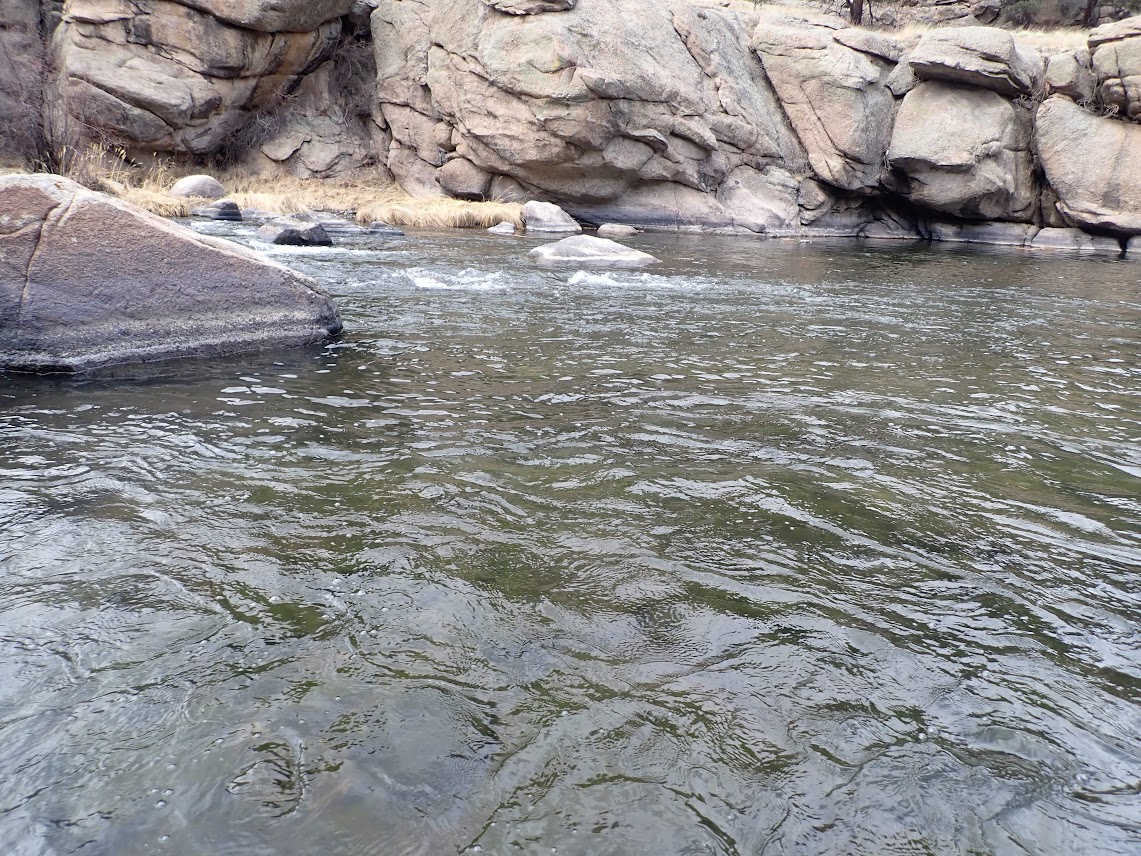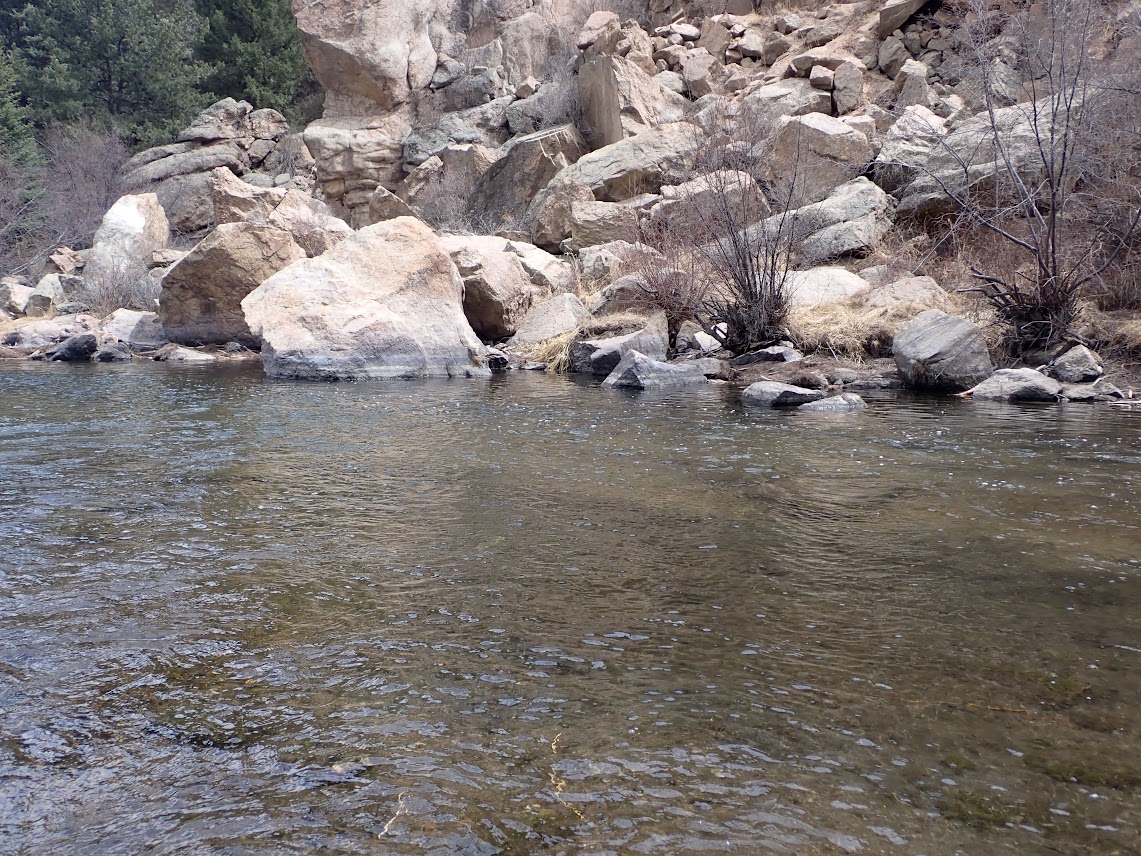Time: 11:00AM – 4:00PM
Location: Eleven Mile Canyon
South Platte River 04/19/2023 Photo Album
Quite a few themes jump out at me, as I look back on my fly fishing adventure on the South Platte River on April 19, 2023. The weather was a prominent factor, as the temperature peaked at 50 degrees around 1PM, and then dark gray clouds dominated the sky resulting in diving temperatures and high winds. Wednesday was not a comfortable day to be fly fishing in Eleven Mile Canyon. The overcast conditions, however, were a critical element that precipitated waves of hatching baetis mayflies throughout the afternoon. The sky darkened, and then the wind picked up, and then the fish began to rise, and eventually another window of sunshine briefly shutdown the surface feeding frenzy. This cycle repeated itself from 1PM until closing time around 4:00PM. A third major negative component of our day on the river was the loss of five hippie stomper flies, but I will expand on that later.
The most significant story line of the day, however, involved having a companion angler along on April 19. I met Nate at the physical therapy center, where I am undergoing treatment for several physical maladies. Nate moved to Colorado last year in August and decided to embrace the sport of fly fishing after years of spin fishing in Pennsylvania. I learned about his new found obsession in one of my early visits to the local PT office, and as the winter evolved, he told me of his frequent trips to Colorado streams during the cold winter months. Most of these river visits resulted in outdoor exercise but minimal success, and I eagerly anticipated inviting him to join me on an excursion, once the weather warmed up. His off day during the week was Wednesday, so April 19 became our first joint fly fishing adventure.
As I tied my workhorse flies through the winter months, I made a point of tying an extra one for Nate, and I provided these to him with each visit. Nate hit me with an abundant quantity of questions, as he attempted to advance his knowledge in the fly fishing game, and after several very successful trips to Eleven Mile Canyon, I decided that the spectacular stretch of the South Platte River would be a great introduction to amazing scenery, high fish density, and a fabulous mayfly hatch.
Nate and I met near Castle Rock, and we transferred his gear to my car, and I made the remaining two hour drive to Eleven Mile Canyon. We parked at my favorite roadside pullout and proceeded to gear up for a day on the river. I pulled on my light down North Face coat and added my rain shell as a windbreaker, however, I made the mistake of ignoring my fingerless woolen gloves and billed hat with earflaps. During our afternoon on the river I would regret this uncharacteristic neglect. The temperature, when we began our hike up the dirt road, was around 45 degrees, but the wind was already gusting with great frequency.

Entry Point to Long Pool
After a short hike we cut down to the river on a steep path. I planned to begin in some attractive pocket water, but a man and woman stopped there before us, so we adjusted and advanced upstream a short distance to a nice pool with a deep run along the western shoreline. Nate rigged with a yellow fat Albert and prince nymph, and I copied his offerings, but I added a third fly in the form of a sparkle wing RS2. We covered the pool and the entering riffles and run thoroughly over the next twenty minutes, but the fish were inattentive. As this scene transpired, the fly fishing couple below us abandoned the pockets and moved past us toward the terrific long pool that I had my eyes on for lunch and the early stages of an anticipated blue winged olive hatch. I decided to move downstream to the pocket water to introduce Nate to some dry/dropper prospecting in faster structure. We spent another twenty minutes casting our rigs in deep runs and pockets among large exposed boulders, and Nate temporarily hooked a small rainbow on the prince, but our efforts were otherwise fruitless. During this time I attempted to act as a guide and directed Nate’s casts to certain areas and explained the logic of why these locations were likely trout homes. Also a head wind made casting a challenge, and I suggested that Nate pause longer on his backcast to load his rod, and this small adjustment greatly improved his casting distance and accuracy.
After completing our exploration of the pocket water, we progressed up the river to the long pool which had by now been abandoned by the man and woman that began below us. We found a large round rock and downed our lunches at noon, and we observed the pool expectantly. Sure enough toward the end of lunch, we noticed a smattering of rises toward the upper and midsection of the pool. After lunch we both removed our dry/dropper configurations, and we both tied on CDC blue winged olive dry flies to hopefully dupe the residents of the long pool. Our lunch time was probably the nicest weather of the day, as the sun broke through, and the temperature spiked around fifty degrees. From 12:30PM until 4PM, the weather followed a steady downward trajectory from the standpoint of human comfort, but a significant upswing for the bad weather-loving mayflies that prompted gluttonous feeding from the trout.

Early Success
Between 12:30 and 2:00 Nate and I feverishly cast to rising trout in the long pool. I managed to land four respectable trout, and Nate brought a rainbow to his net after quite a few temporary connections. This period of fishing was by no means a walk in the park, as I probably made twenty-five fruitless casts for every successful take. I toggled back and forth between the CDC BWO and a Craven soft hackle emerger fished in the surface film as a dry fly, but each fly was consistently ignored with only an intermittent favorable response. During this time we both struggled to track our tiny CDC BWO flies, so we each added a hippie stomper as the front fly and trailed the small BWO imitation on an eight inch dropper, and this improved our ability to track our flies immeasurably. This ploy remained in effect for the remainder of the day, but unfortunately there was a heavy price to pay in lost flies, as five hippie stompers were left behind in the mouths of trout or in bankside bushes. In my case two stompers parted ways, when I set the hook on feeding fish. I only had myself to blame, as I was being cheap and using 5X tippet that a salesman gave me at the Fly Fishing Show two years ago. I failed to abide by the axiom to replace monofilament every season, and using an off brand that I never tested was probably another big mistake. One of the first things I did on Thursday was to buy a new spool of Scientific Anglers 5X.

Respectable

Lots of Fish in This Area

Another Take
By 2:00PM a lull in surface feeding prompted us to explore new water, so we hiked up the river for fifty yards until we reached another favorite pool just below the huge bend pool. Two fishermen were perched along the north bank of the bend pool, so we paused in the lower water and observed for a few minutes. As expected, we began to note rises in the lower section and along the eastern shoreline, so we spaced ourselves apart and began lobbing casts to our targeted feeders. I managed a fine brown trout from the gut of the pool just before the main current deflected off some large boulders, and Nate once again tallied some temporary connections. I also set the hook on a sip on a downstream drift, but the fish turned immediately, as I lifted, and both flies parted from my line. Needless to say, I was not pleased with this turn of events.

A Second Pool to Explore

Long and Slender
By 2:30PM we had flogged the lower pool mercilessly, and the fish were in a rest period, so we once again waded up the river to the large bend pool. The two anglers had by now departed, so we had the entire honey hole to ourselves. For the last 1.5 hours we fired cast after cast to the upper and middle sections of the pool. By now the weather had transformed from intermittent periods of nastiness to constant misery. The wind gusted relentlessly and snow squalls pelted the surface and our beings with small white pellets. Our feet and hands quickly morphed into stumps and claws, and tying knots became an exercise in manipulating stiff fingers. Of course, the worse the weather, the happier the fish. Wave after wave of baetis mayflies emerged and tumbled across the surface, and the trout were completely tuned in. Once again my conversion rate was pathetic, as I probably executed twenty-five empty drifts for every take, but the effort was worthwhile, when shimmering wild trout rested in my net.

Appreciated

Big Smile
I moved my fish count from five to ten, and several of the netted fish were gorgeous ink spotted brown trout in the thirteen inch range. Nate, meanwhile exhibited the characteristics of a newly addicted fly fisherman, as he persevered through the inclement weather to land a magnificent brown trout in the fifteen inch range. In addition, he reported quite a few temporary hook ups, so the numbers could have easily doubled or tripled with a higher conversion rate. The look of pride on Nate’s face, as he cradled the appreciated brown trout said it all.

Midsection of the Big Bend Pool

Dave Displays a Catch
At one point we attempted to abandon the bend pool to explore another favorite area upstream, but when we rounded the bend, we discovered another angler stationed in our desired destination. We quickly retreated to the bend pool to resume our pursuit of trout. By 4PM the cadence of rises waned to sporadic rises, and our feet and hands were screaming for relief. We agreed that the prospect of heated seats and warm hands outweighed the expectation of landing more trout, so we reversed our direction and eventually returned to the car.

Centered in the Net
My success rate on Wednesday was not as high as that which I experienced on my previous two trips to Eleven Mile Canyon, but I was more than pleased with the results. Being able to observe Nate’s introduction to the canyon and a heavy mayfly hatch was very rewarding, and I am certain that he is a confirmed fly fishing addict. The wind and cold were more adverse than the conditions I faced on Friday, April 14, yet we persisted and enjoyed a successful day. For some reason strong wind always seems to impact my ability to fool trout on tiny blue winged olive imitations, and I suspect movement plays a significant role in this letdown. Perhaps Nate can help me solve the challenge of catching trout during windy conditions with blue winged olive imitations.
Fish Landed: 10
Like this:
Like Loading...
